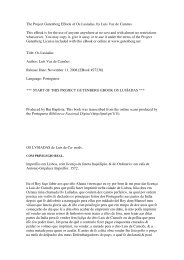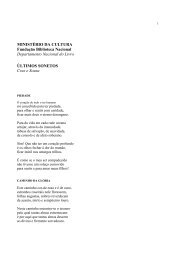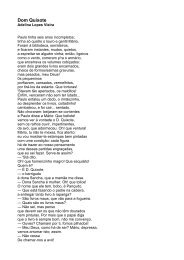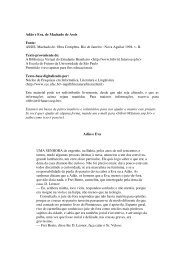Create successful ePaper yourself
Turn your PDF publications into a flip-book with our unique Google optimized e-Paper software.
soldiers proc<strong>la</strong>imed another emperor, Vitellius was found hiding in his pa<strong>la</strong>ce. He was<br />
dragged out into the Forum and killed on the Gemoniae (les Gémonies), a staircase<br />
which went up the Capitoline Hill and on which the corpses of criminals were exposed<br />
before being thrown into the Tiber. This is the Escalier referred to in the next line.<br />
L. 57. These tortures were not known in Rome. They suggest rather the Middle Ages.<br />
le cirque. The circus where chariot-races took p<strong>la</strong>ce. Hugo seems to be confusing it with<br />
the Colosseum, where the g<strong>la</strong>diatorial combats were fought.<br />
Le noir gouffre cloaque. The Cloaca Maxima was the great sewer of Rome. It is still in<br />
existence and in use. Hugo here first makes it the symbol of the <strong>des</strong>truction towards<br />
which the Roman Empire was tending, and then treats it half as a concrete reality, half<br />
as a figure for some underworld in which dethroned but living emperors meet. This<br />
blending of the symbol and the thing symbolized is characteristic of the poet.<br />
chiffres du fatal nombre: the figures or digits that stand for the doomed number, i.e. the<br />
number with which a doomed man is marked.<br />
Atti<strong>la</strong>, the famous king of the Huns, 'the Scourge of God' as he was called, reigned A.D.<br />
434-53.<br />
LE MARIAGE DE ROLAND.<br />
The poem is founded on the 'Chanson de Girart de Viane,' one of the Carolingian cycles<br />
of epic poems, written by Bertrand de Bar-sur-Aube, a poet of Champagne who lived in<br />
the first half of the thirteenth century.<br />
The story, as told in the Chanson, is as follows:—<br />
Girard, or Girart, the son of Garin of Montg<strong>la</strong>ve, a poor nobleman, goes with his brother<br />
Renier to the court of Charlemagne to seek his fortune. After being at court for some<br />
time he quarrelled with the Emperor, owing to the <strong>la</strong>tter marrying the widow of Aubery,<br />
duc de Bourgogne, who was pledged to Girart. As a compensation for the loss of his<br />
bride, he was given the Comté of Vienne, in Dauphiné. When he presented himself<br />
before Charlemagne to do homage, the queen, whose affection for her old lover had<br />
changed to contempt, forced him by a trick to kiss her foot instead of that of her<br />
husband. Some time after, Girart learnt the truth, and, furious at the insult p<strong>la</strong>ced upon<br />
him, he rebelled against his sovereign. Renier, who had been made duke of Genoa, with<br />
his son Olivier and his daughter '<strong>la</strong> belle Aude,' came to help him. Charlemagne<br />
besieged Vienne with a great army, and amongst his warriors was his nephew Ro<strong>la</strong>nd,<br />
who was his principal champion, just as Olivier was that of Girart. A siege, like that of<br />
Troy, ensued, many doughty deeds being done by the two heroes. In the course of the<br />
fighting Ro<strong>la</strong>nd sees Aude and falls in love with her. He takes her prisoner, and almost<br />
succeeds in carrying her off to his tent, but Olivier rescues her. Finally, it is agreed that<br />
the quarrel between the monarch and his vassal shall be settled by a duel between the<br />
two champions. Needless to say, the <strong>la</strong>tter fall in readily with the proposal. Olivier is<br />
armed by an aged Jew, Joachim, who with others of his nation had fled to Vienne with

















